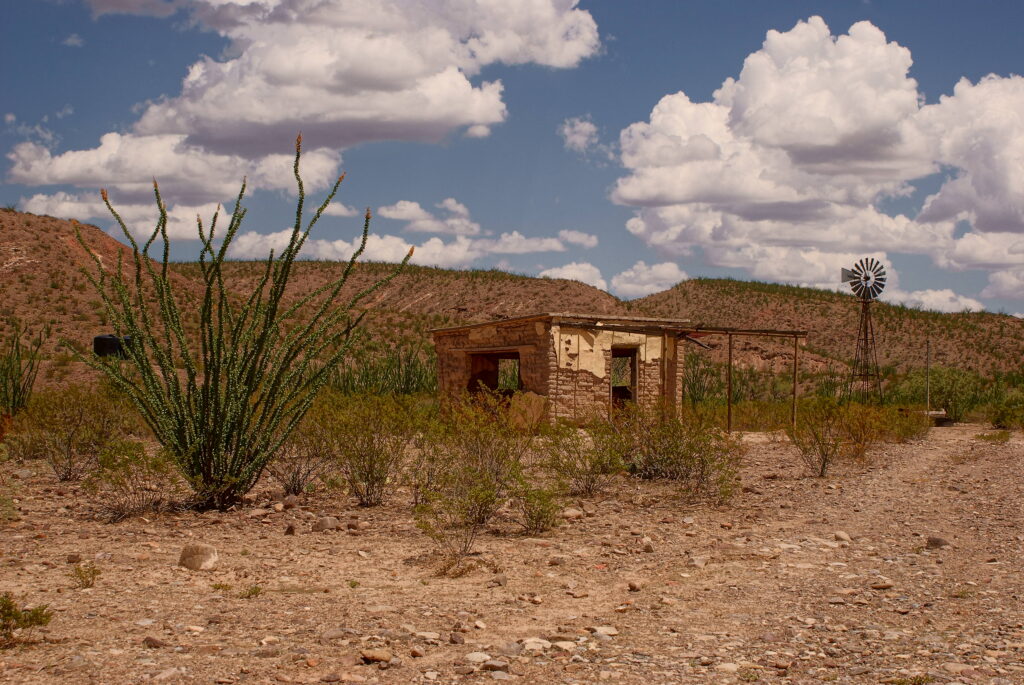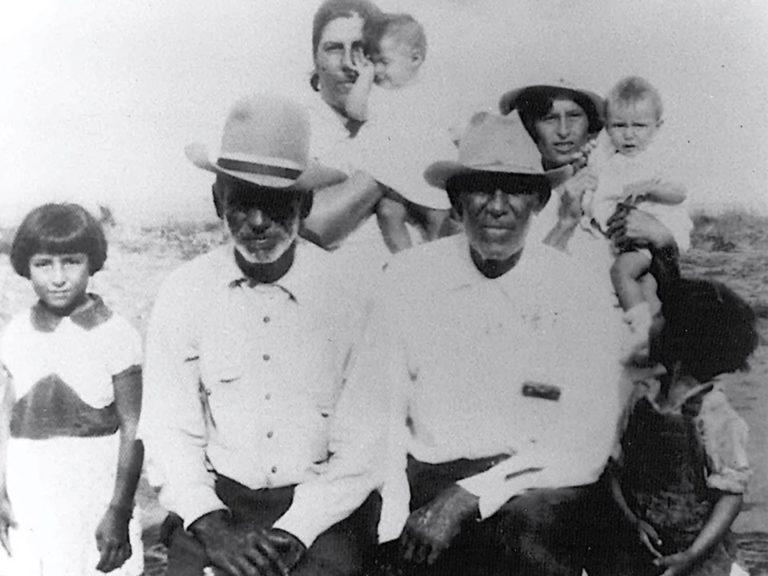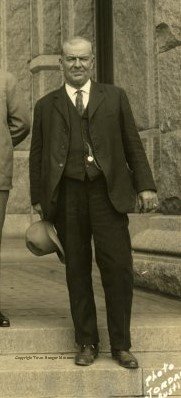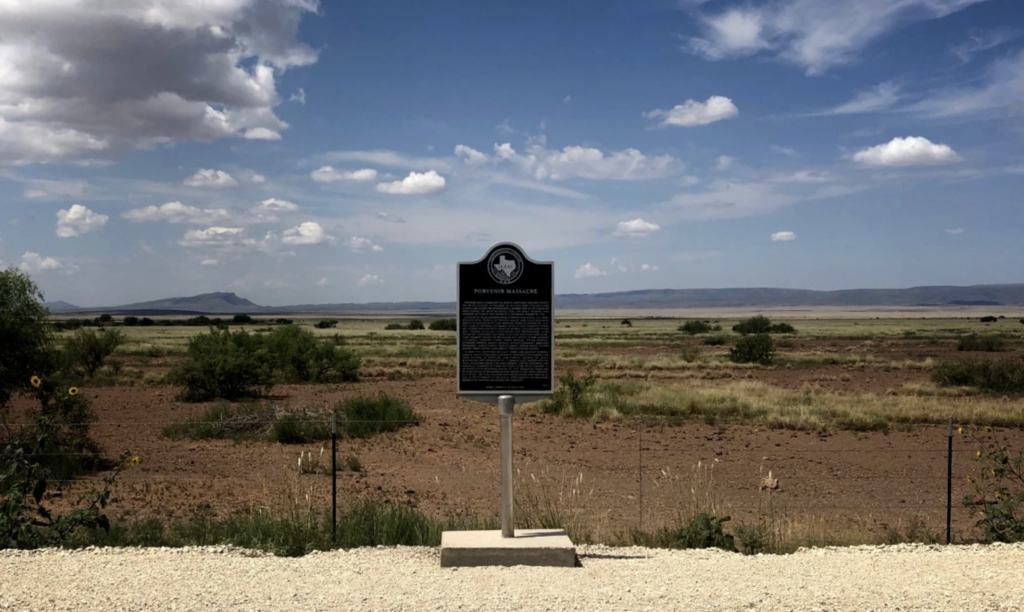#OTD on January 28, 1918, Texas Rangers massacred fifteen men and boys at the village of Porvenir, Texas, in what is perhaps the single most notorious and consequential event in the history of the Ranger Force.

Porvenir was a small and remote, but proudly independent community. Mexican-descent families raised livestock, grew produce and cotton, irrigated their lands, and maintained a school in the harsh Chihuahua desert on the banks of the Rio Grande in northwest Presidio County.

The ostensible reason for the presence of Company B of the Texas Rangers was a raid on the prominent Anglo-owned Brite Ranch in December by Villistas from Mexico, although no evidence surfaced connecting the residents of Porvenir to this attack. Company B was under the command of James Monroe Fox, who in recent years had openly boasted of killing Mexican-descent people without even a semblance of due process, and posed for photos with the corpses.

James Monroe Fox, probably 1920s or 30s. The text of one of his telegrams to the Ranger headquarters in 1915 read “Yesterday we caught a Mexican by the name of Thomas Aguilar one of the three that robed the Depot at Combs and sit the R.R. bridge on fire to which he admitted and was also in the killing of Mr. Austin & Son of course he tried to make his escape but we killed him.” See Johnson, Revolution in Texas, 113. For photo, click here.
Rangers from Company B came to Porvenir on January 24, 1918, rousted residents out of bed and searched their homes at gunpoint. They took three men – Román Nieves, Nutemio González, and Manuel Fierro – prisoners, but released them two days later. More Rangers returned on January 28, accompanied by local ranchmen Buck Pool, John Pool, Tom Snyder, and Raymond Fitzgerald, as well as soldiers from the 8th U.S. Cavalry regiment. Rangers separated 15 men and boys, took them away from the rest of the village, lined them, and shot them. The victims included Antonio Castañeda, Longino Flores, Pedro Herrera, Vivian Herrera, Severiano Herrera, Manuel Moralez, Eutimio Gonzalez, Ambrosio Hernandez, Alberto Garcia, Tiburcio Jáques, Roman Nieves, Serapio Jimenez, Pedro Jimenez, Juan Jimenez, and Macedonio Huertas. /
Survivors fled the village. They found refuge in Mexico and returned only to bring the remains of their loved ones to Mexico for burial. Fox and the ranchers claimed they were just returning fire and Porvenir residents were “thieves,” but investigations by Mexican consuls, U. S. soldiers, and the United States State Department found that they were killed unarmed while under the custody of Rangers.
In June, the Texas governor disbanded company B, firing Rangers Andrew Charles Baker, Max Herman, Bud Weaver, Allen Cole, and Boone Oliphant, and pressured Fox to resign. This was a rare occasion when Rangers faced dismissal and public reprimand for illegal violence. Mexican Ambassador Ignacio Bonillas wrote to U.S. Secretary of State Robert Lansing and expressed his hope that a “judicial investigation there may result not only the resignation of the Captain of the rangers, J. M. Fox, but the punishment which he and the others who are found guilty merit, because this is demanded by justice and the good name of the Federal authorities and of the State of Texas.”
Despite extensive evidence of a crime, nobody was prosecuted for this mass murder. Not only was there no such investigation, but Fox returned to the Ranger Force as Captain from 1925-1927, and as a Special Ranger from 1934-5.
Yet the massacre has reverberated for more than a century. It was a critical event prompting Representative José Tomás Canales to launch a legislative investigation of the Ranger Force in 1919, in which he described the act as “cold-blooded murder.” Families of the victims collected evidence and filed a claim against the United States in 1926, eight years after the massacre, as Refusing to Forget member Monica Muñoz Martínez recounts in her book The Injustice Never Leaves You.
Robert Keil, a soldier who was present the night of the massacre and haunted by it, recorded his memories in the hope that they would help the truth come to light. They were published posthumously in 2002 by the Center for Big Bend Studies at Sul Ross State University. The same year, Juan Bonilla Flores, who was a 12 year old survivor and son of victim Longino Flores, gave an interview to documentarian Gode Davis for a film on lynching in U.S. History. He was 98 years old, and like Keil had been haunted by the violence for his whole life. Juan Bonilla Flores’ daughter, Benita Albarado, worked tirelessly for decades collecting evidence about the massacre. Albarado worked closely with Monica Martinez on her book research and with Refusing to Forget on a museum exhibit. Arlinda Valencia, a descendant of Longino Flores, created a website about Porvenir, including a lesson plan, and organized a gathering of four hundred Porvenir descendants and supporters at the TX capitol in 2018 on the centennial of the massacre.
The massacre was so egregious that even the Texas Ranger Museum recognizes its importance, though it presents Fox’s account as credible and displays his commission and a gun he supposedly carried. Did Fox use this weapon to murder in the 1910s? Writing in the magazine Cowboys and Indians (!), Ranger Hall of Fame and Museum development director Jody Ginn denies that the massacre was state-sanctioned violence, falsely stating that Fox and others were indicted, not mentioning Fox’s rehiring, and ignoring the glowing exhibit in Fox’s honor at the museum.
In 2019, PBS broadcast the film “Porvenir, Texas,” which among other achievements brought Juan Bonilla Flores’ testimony to a national audience. As part of Refusing to Forget’s efforts, Monica Martínez applied for a historical marker from the Texas Historical Commission. It was unveiled in 2018, though not without opposition from member of the county’s historical commission. The marker is located 29 miles west of Marfa, TX on Highway 90, as a belated but meaningful recognition of a great crime and tragedy. Votive candles, tobacco, stones, and other offerings are left at its base. Porvenir is remembered.

